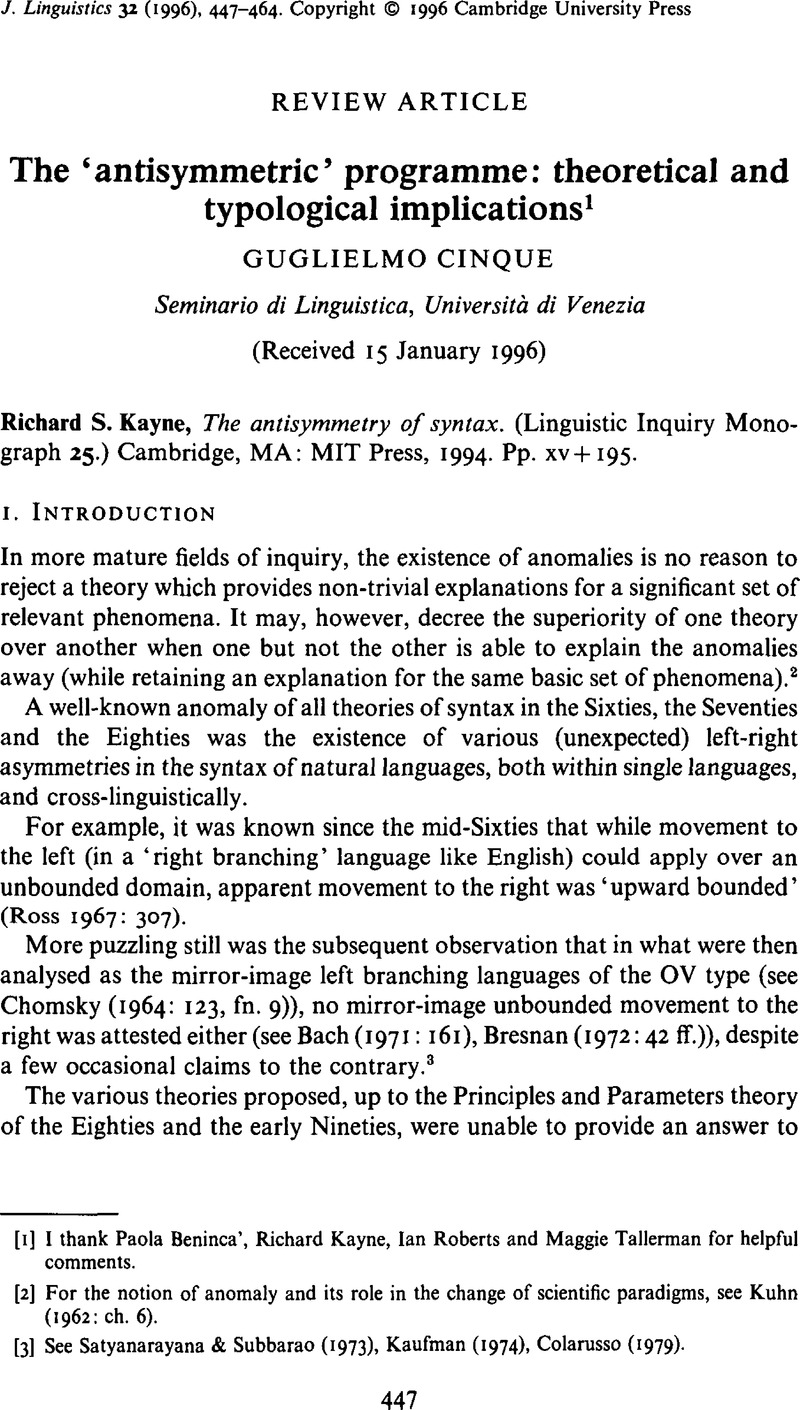Crossref Citations
This article has been cited by the following publications. This list is generated based on data provided by Crossref.
Ernst, Thomas
2001.
The Syntax of Adjuncts.
Ackema, Peter
and
Neeleman, Ad
2002.
Storage and Computation in the Language Faculty.
Vol. 30,
Issue. ,
p.
219.
KUWABARA, KAZUKI
2003.
Antisymmetry, Linearization and Movement (A. Moro, Dynamic Antisymmetry).
ENGLISH LINGUISTICS,
Vol. 20,
Issue. 1,
p.
274.
KAYNE, RICHARD S.
2003.
ANTISYMMETRY AND JAPANESE.
ENGLISH LINGUISTICS,
Vol. 20,
Issue. 1,
p.
1.
Thomas, Margaret
2003.
Plato's problems and Plato's problem.
Language & Communication,
Vol. 23,
Issue. 1,
p.
81.
Rosen, Nicole
2003.
Demonstrative Position in Michif.
Canadian Journal of Linguistics/Revue canadienne de linguistique,
Vol. 48,
Issue. 1-2,
p.
39.
Shlonsky, Ur
2004.
The form of Semitic noun phrases.
Lingua,
Vol. 114,
Issue. 12,
p.
1465.
Cinque, Guglielmo
2005.
Deriving Greenberg's Universal 20 and Its Exceptions.
Linguistic Inquiry,
Vol. 36,
Issue. 3,
p.
315.
Willis, David
2006.
Against N-raising and NP-raising analyses of Welsh noun phrases.
Lingua,
Vol. 116,
Issue. 11,
p.
1807.
Escribano, José Luis González
2006.
NPs as just NPs.
Language Sciences,
Vol. 28,
Issue. 6,
p.
529.
Cinque, Guglielmo
2009.
Universals of Language Today.
Vol. 76,
Issue. ,
p.
165.
Lust, Barbara
2010.
Processing and Producing Head-final Structures.
Vol. 38,
Issue. ,
p.
369.
TOKIZAKI, HISAO
2011.
INTRODUCTION: LINEAR INFORMATION ACROSS GRAMMAR.
ENGLISH LINGUISTICS,
Vol. 28,
Issue. 2,
p.
222.
Barrie, Michael
2011.
Dynamic Antisymmetry and the Syntax of Noun Incorporation.
Vol. 84,
Issue. ,
p.
23.
Joseph, John E.
and
Newmeyer, Frederick J.
2012.
‘All Languages Are Equally Complex’.
Historiographia Linguistica,
Vol. 39,
Issue. 2-3,
p.
341.
Abels, Klaus
and
Neeleman, Ad
2012.
Linear Asymmetries and the LCA.
Syntax,
Vol. 15,
Issue. 1,
p.
25.
2013.
An Annotated Syntax Reader ‐ Lasting Insights and Questions.
p.
533.
2013.
An Annotated Syntax Reader ‐ Lasting Insights and Questions.
p.
569.
Kahnemuyipour, Arsalan
2014.
Revisiting the Persian Ezafe construction: A roll-up movement analysis.
Lingua,
Vol. 150,
Issue. ,
p.
1.
Elfner, Emily
2015.
Recursion in prosodic phrasing: evidence from Connemara Irish.
Natural Language & Linguistic Theory,
Vol. 33,
Issue. 4,
p.
1169.





